Pearson BTEC HNC Construction Handbook 2022-2023, Uxbridge College
VerifiedAdded on 2023/02/06
|54
|20450
|97
Report
AI Summary
This document serves as the comprehensive handbook for the Pearson BTEC Level 4 Higher National Certificate in Construction and the Built Environment (Construction) program at Uxbridge College for the academic year 2022-2023. It provides a detailed overview of the course structure, including the program code, frameworks, and unit specifications. The handbook outlines the assessment procedures, covering course structure, RQF levels, unit details, guided and independent study expectations, and the total qualification time. It also details the learning and assessment methodologies, including unit assessments, assignment briefs, submission guidelines, marking and grading criteria, and policies on late submissions and resubmissions. Furthermore, the handbook covers essential aspects of student support, including HE student representation, engagement, rules, responsibilities, learning resources, and support services. Additional sections address disciplinary procedures, academic appeals, and academic malpractice. Appendices include study guides, application forms, and a glossary of terms. This handbook is a crucial resource for students, offering a complete guide to successfully navigating the HNC program at Uxbridge College. This document is available on Desklib, a platform providing students with past papers and solved assignments to aid in their studies.

CONSTRUCTION & THE BUILT ENVIRONMENT
UXBRIDGE COLLEGE
2022-2023
Pearson BTEC Level 4 Higher National
Certificate in Construction and the Built
Environment (Construction) 2022-2023
UXBRIDGE COLLEGE
2022-2023
Pearson BTEC Level 4 Higher National
Certificate in Construction and the Built
Environment (Construction) 2022-2023
Paraphrase This Document
Need a fresh take? Get an instant paraphrase of this document with our AI Paraphraser
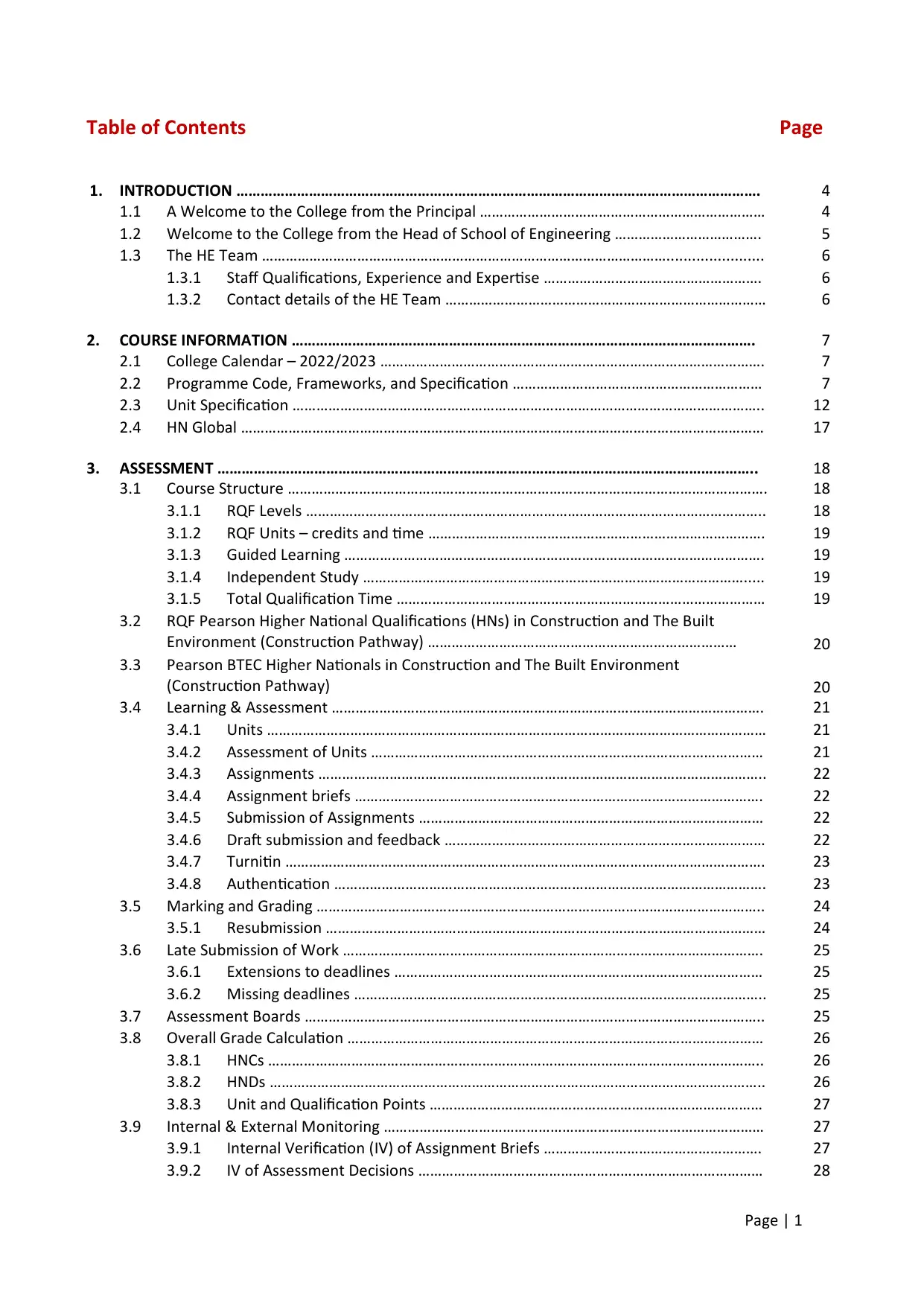
Page | 1
Table of Contents Page
1. INTRODUCTION …………………………………………………………………………………………………………………. 4
1.1 A Welcome to the College from the Principal ……………………………………………………………… 4
1.2 Welcome to the College from the Head of School of Engineering ………………………………. 5
1.3 The HE Team …………………………………………………………………………………………....................... 6
1.3.1 Staff Qualifications, Experience and Expertise ………………………………………………. 6
1.3.2 Contact details of the HE Team ……………………………………………………………………… 6
2. COURSE INFORMATION ……………………………………………………………………………………………………. 7
2.1 College Calendar – 2022/2023 ……………………………………………………………………………………. 7
2.2 Programme Code, Frameworks, and Specification ……………………………………………………… 7
2.3 Unit Specification ……………………………………………………………………………………………………….. 12
2.4 HN Global …………………………………………………………………………………………………………………… 17
3. ASSESSMENT …………………………………………………………………………………………………………………….. 18
3.1 Course Structure …………………………………………………………………………………………………………. 18
3.1.1 RQF Levels …………………………………………………………………………………………………….. 18
3.1.2 RQF Units – credits and time …………………………………………………………………………. 19
3.1.3 Guided Learning ……………………………………………………………………………………………. 19
3.1.4 Independent Study ……………………………………………………………………………………..... 19
3.1.5 Total Qualification Time ………………………………………………………………………………… 19
3.2 RQF Pearson Higher National Qualifications (HNs) in Construction and The Built
Environment (Construction Pathway) …………………………………………………………………… 20
3.3 Pearson BTEC Higher Nationals in Construction and The Built Environment
(Construction Pathway) 20
3.4 Learning & Assessment ………………………………………………………………………………………………. 21
3.4.1 Units ……………………………………………………………………………………………………………… 21
3.4.2 Assessment of Units ……………………………………………………………………………………… 21
3.4.3 Assignments ………………………………………………………………………………………………….. 22
3.4.4 Assignment briefs …………………………………………………………………………………………. 22
3.4.5 Submission of Assignments …………………………………………………………………………… 22
3.4.6 Draft submission and feedback ……………………………………………………………………… 22
3.4.7 Turnitin …………………………………………………………………………………………………………. 23
3.4.8 Authentication ………………………………………………………………………………………………. 23
3.5 Marking and Grading ………………………………………………………………………………………………….. 24
3.5.1 Resubmission ………………………………………………………………………………………………… 24
3.6 Late Submission of Work ……………………………………………………………………………………………. 25
3.6.1 Extensions to deadlines ………………………………………………………………………………… 25
3.6.2 Missing deadlines ………………………………………………………………………………………….. 25
3.7 Assessment Boards …………………………………………………………………………………………………….. 25
3.8 Overall Grade Calculation …………………………………………………………………………………………… 26
3.8.1 HNCs …………………………………………………………………………………………………………….. 26
3.8.2 HNDs …………………………………………………………………………………………………………….. 26
3.8.3 Unit and Qualification Points ………………………………………………………………………… 27
3.9 Internal & External Monitoring …………………………………………………………………………………… 27
3.9.1 Internal Verification (IV) of Assignment Briefs ………………………………………………. 27
3.9.2 IV of Assessment Decisions …………………………………………………………………………… 28
Table of Contents Page
1. INTRODUCTION …………………………………………………………………………………………………………………. 4
1.1 A Welcome to the College from the Principal ……………………………………………………………… 4
1.2 Welcome to the College from the Head of School of Engineering ………………………………. 5
1.3 The HE Team …………………………………………………………………………………………....................... 6
1.3.1 Staff Qualifications, Experience and Expertise ………………………………………………. 6
1.3.2 Contact details of the HE Team ……………………………………………………………………… 6
2. COURSE INFORMATION ……………………………………………………………………………………………………. 7
2.1 College Calendar – 2022/2023 ……………………………………………………………………………………. 7
2.2 Programme Code, Frameworks, and Specification ……………………………………………………… 7
2.3 Unit Specification ……………………………………………………………………………………………………….. 12
2.4 HN Global …………………………………………………………………………………………………………………… 17
3. ASSESSMENT …………………………………………………………………………………………………………………….. 18
3.1 Course Structure …………………………………………………………………………………………………………. 18
3.1.1 RQF Levels …………………………………………………………………………………………………….. 18
3.1.2 RQF Units – credits and time …………………………………………………………………………. 19
3.1.3 Guided Learning ……………………………………………………………………………………………. 19
3.1.4 Independent Study ……………………………………………………………………………………..... 19
3.1.5 Total Qualification Time ………………………………………………………………………………… 19
3.2 RQF Pearson Higher National Qualifications (HNs) in Construction and The Built
Environment (Construction Pathway) …………………………………………………………………… 20
3.3 Pearson BTEC Higher Nationals in Construction and The Built Environment
(Construction Pathway) 20
3.4 Learning & Assessment ………………………………………………………………………………………………. 21
3.4.1 Units ……………………………………………………………………………………………………………… 21
3.4.2 Assessment of Units ……………………………………………………………………………………… 21
3.4.3 Assignments ………………………………………………………………………………………………….. 22
3.4.4 Assignment briefs …………………………………………………………………………………………. 22
3.4.5 Submission of Assignments …………………………………………………………………………… 22
3.4.6 Draft submission and feedback ……………………………………………………………………… 22
3.4.7 Turnitin …………………………………………………………………………………………………………. 23
3.4.8 Authentication ………………………………………………………………………………………………. 23
3.5 Marking and Grading ………………………………………………………………………………………………….. 24
3.5.1 Resubmission ………………………………………………………………………………………………… 24
3.6 Late Submission of Work ……………………………………………………………………………………………. 25
3.6.1 Extensions to deadlines ………………………………………………………………………………… 25
3.6.2 Missing deadlines ………………………………………………………………………………………….. 25
3.7 Assessment Boards …………………………………………………………………………………………………….. 25
3.8 Overall Grade Calculation …………………………………………………………………………………………… 26
3.8.1 HNCs …………………………………………………………………………………………………………….. 26
3.8.2 HNDs …………………………………………………………………………………………………………….. 26
3.8.3 Unit and Qualification Points ………………………………………………………………………… 27
3.9 Internal & External Monitoring …………………………………………………………………………………… 27
3.9.1 Internal Verification (IV) of Assignment Briefs ………………………………………………. 27
3.9.2 IV of Assessment Decisions …………………………………………………………………………… 28
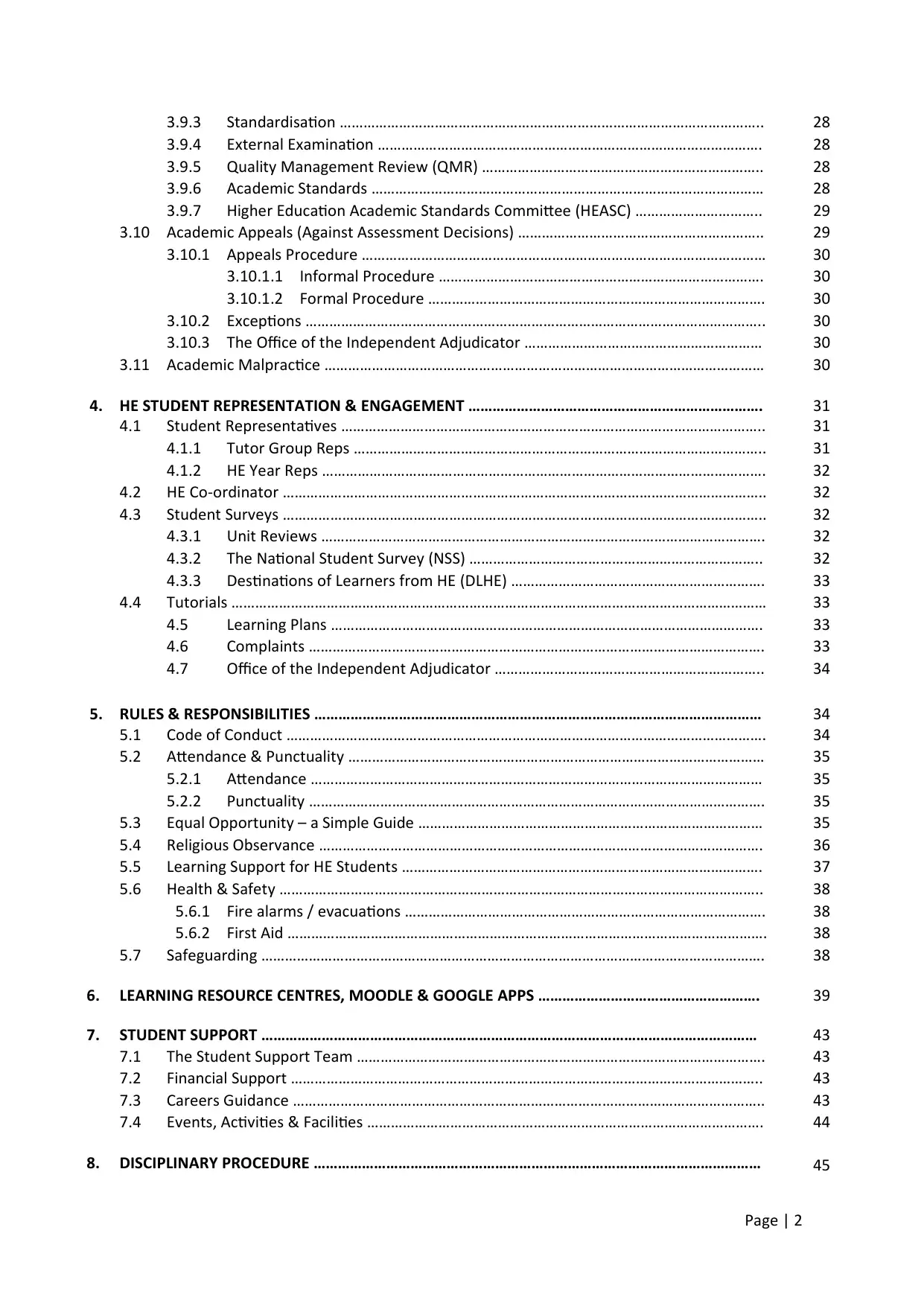
Page | 2
3.9.3 Standardisation …………………………………………………………………………………………….. 28
3.9.4 External Examination ……………………………………………………………………………………. 28
3.9.5 Quality Management Review (QMR) …………………………………………………………….. 28
3.9.6 Academic Standards ……………………………………………………………………………………… 28
3.9.7 Higher Education Academic Standards Committee (HEASC) ………………………….. 29
3.10 Academic Appeals (Against Assessment Decisions) …………………………………………………….. 29
3.10.1 Appeals Procedure ………………………………………………………………………………………… 30
3.10.1.1 Informal Procedure ………………………………………………………………………. 30
3.10.1.2 Formal Procedure …………………………………………………………………………. 30
3.10.2 Exceptions …………………………………………………………………………………………………….. 30
3.10.3 The Office of the Independent Adjudicator …………………………………………………… 30
3.11 Academic Malpractice ………………………………………………………………………………………………… 30
4. HE STUDENT REPRESENTATION & ENGAGEMENT ………………………………………………………………. 31
4.1 Student Representatives …………………………………………………………………………………………….. 31
4.1.1 Tutor Group Reps ………………………………………………………………………………………….. 31
4.1.2 HE Year Reps …………………………………………………………………………………………………. 32
4.2 HE Co-ordinator ………………………………………………………………………………………………………….. 32
4.3 Student Surveys ………………………………………………………………………………………………………….. 32
4.3.1 Unit Reviews …………………………………………………………………………………………………. 32
4.3.2 The National Student Survey (NSS) ……………………………………………………………….. 32
4.3.3 Destinations of Learners from HE (DLHE) ………………………………………………………. 33
4.4 Tutorials ……………………………………………………………………………………………………………………… 33
4.5 Learning Plans ………………………………………………………………………………………………. 33
4.6 Complaints ……………………………………………………………………………………………………. 33
4.7 Office of the Independent Adjudicator ………………………………………………………….. 34
5. RULES & RESPONSIBILITIES ………………………………………………………………………………………………… 34
5.1 Code of Conduct …………………………………………………………………………………………………………. 34
5.2 Attendance & Punctuality …………………………………………………………………………………………… 35
5.2.1 Attendance …………………………………………………………………………………………………… 35
5.2.2 Punctuality ……………………………………………………………………………………………………. 35
5.3 Equal Opportunity – a Simple Guide …………………………………………………………………………… 35
5.4 Religious Observance …………………………………………………………………………………………………. 36
5.5 Learning Support for HE Students ………………………………………………………………………………. 37
5.6 Health & Safety ………………………………………………………………………………………………………….. 38
5.6.1 Fire alarms / evacuations ………………………………………………………………………………. 38
5.6.2 First Aid …………………………………………………………………………………………………………. 38
5.7 Safeguarding ………………………………………………………………………………………………………………. 38
6. LEARNING RESOURCE CENTRES, MOODLE & GOOGLE APPS ………………………………………………. 39
7. STUDENT SUPPORT …………………………………………………………………………………………………………… 43
7.1 The Student Support Team …………………………………………………………………………………………. 43
7.2 Financial Support ……………………………………………………………………………………………………….. 43
7.3 Careers Guidance ……………………………………………………………………………………………………….. 43
7.4 Events, Activities & Facilities ………………………………………………………………………………………. 44
8. DISCIPLINARY PROCEDURE ………………………………………………………………………………………………… 45
3.9.3 Standardisation …………………………………………………………………………………………….. 28
3.9.4 External Examination ……………………………………………………………………………………. 28
3.9.5 Quality Management Review (QMR) …………………………………………………………….. 28
3.9.6 Academic Standards ……………………………………………………………………………………… 28
3.9.7 Higher Education Academic Standards Committee (HEASC) ………………………….. 29
3.10 Academic Appeals (Against Assessment Decisions) …………………………………………………….. 29
3.10.1 Appeals Procedure ………………………………………………………………………………………… 30
3.10.1.1 Informal Procedure ………………………………………………………………………. 30
3.10.1.2 Formal Procedure …………………………………………………………………………. 30
3.10.2 Exceptions …………………………………………………………………………………………………….. 30
3.10.3 The Office of the Independent Adjudicator …………………………………………………… 30
3.11 Academic Malpractice ………………………………………………………………………………………………… 30
4. HE STUDENT REPRESENTATION & ENGAGEMENT ………………………………………………………………. 31
4.1 Student Representatives …………………………………………………………………………………………….. 31
4.1.1 Tutor Group Reps ………………………………………………………………………………………….. 31
4.1.2 HE Year Reps …………………………………………………………………………………………………. 32
4.2 HE Co-ordinator ………………………………………………………………………………………………………….. 32
4.3 Student Surveys ………………………………………………………………………………………………………….. 32
4.3.1 Unit Reviews …………………………………………………………………………………………………. 32
4.3.2 The National Student Survey (NSS) ……………………………………………………………….. 32
4.3.3 Destinations of Learners from HE (DLHE) ………………………………………………………. 33
4.4 Tutorials ……………………………………………………………………………………………………………………… 33
4.5 Learning Plans ………………………………………………………………………………………………. 33
4.6 Complaints ……………………………………………………………………………………………………. 33
4.7 Office of the Independent Adjudicator ………………………………………………………….. 34
5. RULES & RESPONSIBILITIES ………………………………………………………………………………………………… 34
5.1 Code of Conduct …………………………………………………………………………………………………………. 34
5.2 Attendance & Punctuality …………………………………………………………………………………………… 35
5.2.1 Attendance …………………………………………………………………………………………………… 35
5.2.2 Punctuality ……………………………………………………………………………………………………. 35
5.3 Equal Opportunity – a Simple Guide …………………………………………………………………………… 35
5.4 Religious Observance …………………………………………………………………………………………………. 36
5.5 Learning Support for HE Students ………………………………………………………………………………. 37
5.6 Health & Safety ………………………………………………………………………………………………………….. 38
5.6.1 Fire alarms / evacuations ………………………………………………………………………………. 38
5.6.2 First Aid …………………………………………………………………………………………………………. 38
5.7 Safeguarding ………………………………………………………………………………………………………………. 38
6. LEARNING RESOURCE CENTRES, MOODLE & GOOGLE APPS ………………………………………………. 39
7. STUDENT SUPPORT …………………………………………………………………………………………………………… 43
7.1 The Student Support Team …………………………………………………………………………………………. 43
7.2 Financial Support ……………………………………………………………………………………………………….. 43
7.3 Careers Guidance ……………………………………………………………………………………………………….. 43
7.4 Events, Activities & Facilities ………………………………………………………………………………………. 44
8. DISCIPLINARY PROCEDURE ………………………………………………………………………………………………… 45
⊘ This is a preview!⊘
Do you want full access?
Subscribe today to unlock all pages.

Trusted by 1+ million students worldwide

Page | 3
APPENDIX 1 – STUDY GUID ………………………………………………………………………………………………………. 46
A How to Write Essays …………………………………………………………………………………………………… 46
B General Presentation ………………………………………………………………………………………………….. 47
C Referencing Your Reading – Reference Lists & Bibliographies …………………………………….. 47
APPENDIX 2 – EXTENUATING CIRCUMSTANCES APPLICATION FORM ………………………………………… 49
APPENDIX 3 – GLOSSARY ………………………………………………………………………………………………………….. 50
APPENDIX 1 – STUDY GUID ………………………………………………………………………………………………………. 46
A How to Write Essays …………………………………………………………………………………………………… 46
B General Presentation ………………………………………………………………………………………………….. 47
C Referencing Your Reading – Reference Lists & Bibliographies …………………………………….. 47
APPENDIX 2 – EXTENUATING CIRCUMSTANCES APPLICATION FORM ………………………………………… 49
APPENDIX 3 – GLOSSARY ………………………………………………………………………………………………………….. 50
Paraphrase This Document
Need a fresh take? Get an instant paraphrase of this document with our AI Paraphraser
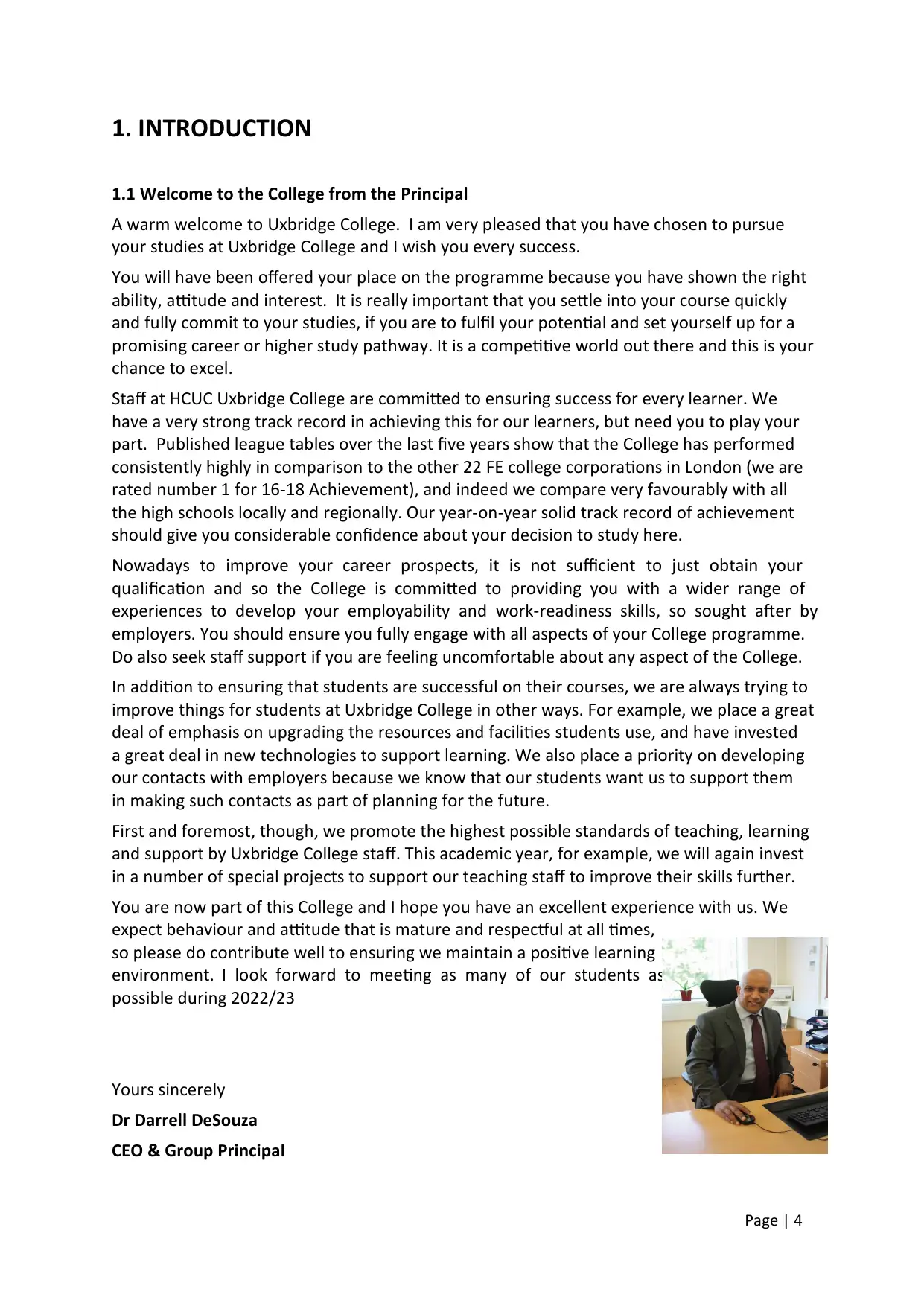
Page | 4
1. INTRODUCTION
1.1 Welcome to the College from the Principal
A warm welcome to Uxbridge College. I am very pleased that you have chosen to pursue
your studies at Uxbridge College and I wish you every success.
You will have been offered your place on the programme because you have shown the right
ability, attitude and interest. It is really important that you settle into your course quickly
and fully commit to your studies, if you are to fulfil your potential and set yourself up for a
promising career or higher study pathway. It is a competitive world out there and this is your
chance to excel.
Staff at HCUC Uxbridge College are committed to ensuring success for every learner. We
have a very strong track record in achieving this for our learners, but need you to play your
part. Published league tables over the last five years show that the College has performed
consistently highly in comparison to the other 22 FE college corporations in London (we are
rated number 1 for 16-18 Achievement), and indeed we compare very favourably with all
the high schools locally and regionally. Our year-on-year solid track record of achievement
should give you considerable confidence about your decision to study here.
Nowadays to improve your career prospects, it is not sufficient to just obtain your
qualification and so the College is committed to providing you with a wider range of
experiences to develop your employability and work-readiness skills, so sought after by
employers. You should ensure you fully engage with all aspects of your College programme.
Do also seek staff support if you are feeling uncomfortable about any aspect of the College.
In addition to ensuring that students are successful on their courses, we are always trying to
improve things for students at Uxbridge College in other ways. For example, we place a great
deal of emphasis on upgrading the resources and facilities students use, and have invested
a great deal in new technologies to support learning. We also place a priority on developing
our contacts with employers because we know that our students want us to support them
in making such contacts as part of planning for the future.
First and foremost, though, we promote the highest possible standards of teaching, learning
and support by Uxbridge College staff. This academic year, for example, we will again invest
in a number of special projects to support our teaching staff to improve their skills further.
You are now part of this College and I hope you have an excellent experience with us. We
expect behaviour and attitude that is mature and respectful at all times,
so please do contribute well to ensuring we maintain a positive learning
environment. I look forward to meeting as many of our students as
possible during 2022/23
Yours sincerely
Dr Darrell DeSouza
CEO & Group Principal
1. INTRODUCTION
1.1 Welcome to the College from the Principal
A warm welcome to Uxbridge College. I am very pleased that you have chosen to pursue
your studies at Uxbridge College and I wish you every success.
You will have been offered your place on the programme because you have shown the right
ability, attitude and interest. It is really important that you settle into your course quickly
and fully commit to your studies, if you are to fulfil your potential and set yourself up for a
promising career or higher study pathway. It is a competitive world out there and this is your
chance to excel.
Staff at HCUC Uxbridge College are committed to ensuring success for every learner. We
have a very strong track record in achieving this for our learners, but need you to play your
part. Published league tables over the last five years show that the College has performed
consistently highly in comparison to the other 22 FE college corporations in London (we are
rated number 1 for 16-18 Achievement), and indeed we compare very favourably with all
the high schools locally and regionally. Our year-on-year solid track record of achievement
should give you considerable confidence about your decision to study here.
Nowadays to improve your career prospects, it is not sufficient to just obtain your
qualification and so the College is committed to providing you with a wider range of
experiences to develop your employability and work-readiness skills, so sought after by
employers. You should ensure you fully engage with all aspects of your College programme.
Do also seek staff support if you are feeling uncomfortable about any aspect of the College.
In addition to ensuring that students are successful on their courses, we are always trying to
improve things for students at Uxbridge College in other ways. For example, we place a great
deal of emphasis on upgrading the resources and facilities students use, and have invested
a great deal in new technologies to support learning. We also place a priority on developing
our contacts with employers because we know that our students want us to support them
in making such contacts as part of planning for the future.
First and foremost, though, we promote the highest possible standards of teaching, learning
and support by Uxbridge College staff. This academic year, for example, we will again invest
in a number of special projects to support our teaching staff to improve their skills further.
You are now part of this College and I hope you have an excellent experience with us. We
expect behaviour and attitude that is mature and respectful at all times,
so please do contribute well to ensuring we maintain a positive learning
environment. I look forward to meeting as many of our students as
possible during 2022/23
Yours sincerely
Dr Darrell DeSouza
CEO & Group Principal
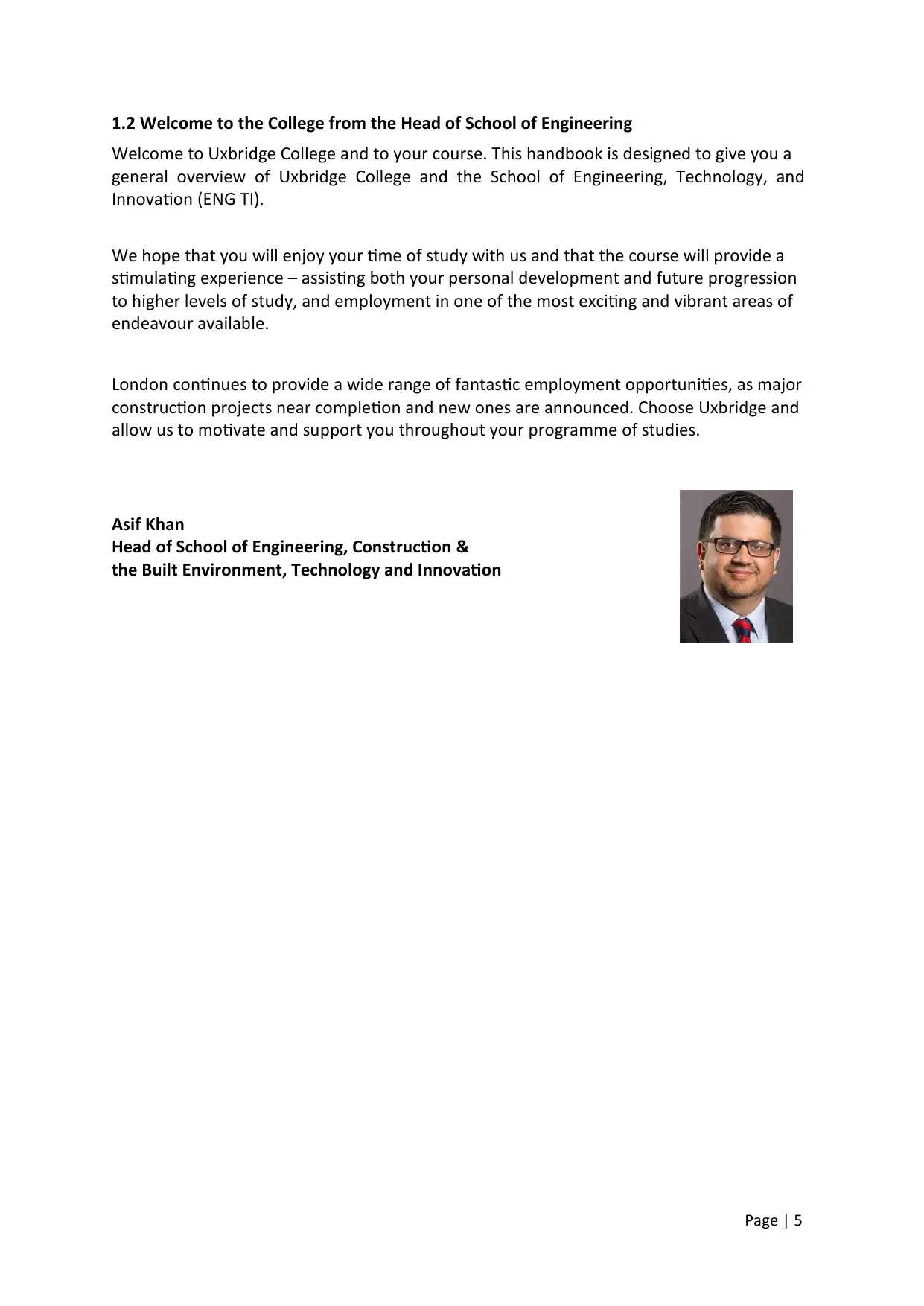
Page | 5
1.2 Welcome to the College from the Head of School of Engineering
Welcome to Uxbridge College and to your course. This handbook is designed to give you a
general overview of Uxbridge College and the School of Engineering, Technology, and
Innovation (ENG TI).
We hope that you will enjoy your time of study with us and that the course will provide a
stimulating experience – assisting both your personal development and future progression
to higher levels of study, and employment in one of the most exciting and vibrant areas of
endeavour available.
London continues to provide a wide range of fantastic employment opportunities, as major
construction projects near completion and new ones are announced. Choose Uxbridge and
allow us to motivate and support you throughout your programme of studies.
Asif Khan
Head of School of Engineering, Construction &
the Built Environment, Technology and Innovation
1.2 Welcome to the College from the Head of School of Engineering
Welcome to Uxbridge College and to your course. This handbook is designed to give you a
general overview of Uxbridge College and the School of Engineering, Technology, and
Innovation (ENG TI).
We hope that you will enjoy your time of study with us and that the course will provide a
stimulating experience – assisting both your personal development and future progression
to higher levels of study, and employment in one of the most exciting and vibrant areas of
endeavour available.
London continues to provide a wide range of fantastic employment opportunities, as major
construction projects near completion and new ones are announced. Choose Uxbridge and
allow us to motivate and support you throughout your programme of studies.
Asif Khan
Head of School of Engineering, Construction &
the Built Environment, Technology and Innovation
⊘ This is a preview!⊘
Do you want full access?
Subscribe today to unlock all pages.

Trusted by 1+ million students worldwide
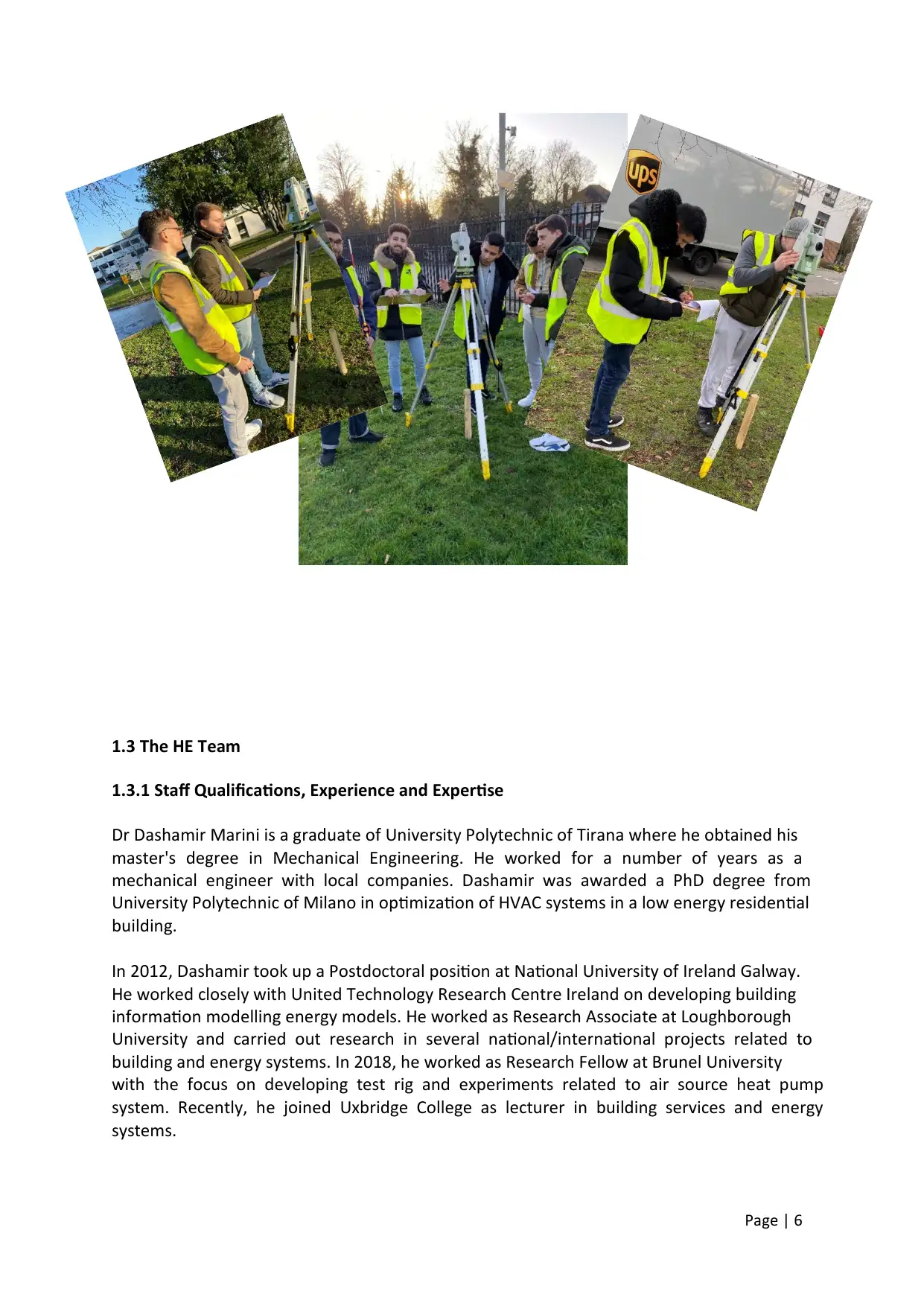
Page | 6
1.3 The HE Team
1.3.1 Staff Qualifications, Experience and Expertise
Dr Dashamir Marini is a graduate of University Polytechnic of Tirana where he obtained his
master's degree in Mechanical Engineering. He worked for a number of years as a
mechanical engineer with local companies. Dashamir was awarded a PhD degree from
University Polytechnic of Milano in optimization of HVAC systems in a low energy residential
building.
In 2012, Dashamir took up a Postdoctoral position at National University of Ireland Galway.
He worked closely with United Technology Research Centre Ireland on developing building
information modelling energy models. He worked as Research Associate at Loughborough
University and carried out research in several national/international projects related to
building and energy systems. In 2018, he worked as Research Fellow at Brunel University
with the focus on developing test rig and experiments related to air source heat pump
system. Recently, he joined Uxbridge College as lecturer in building services and energy
systems.
1.3 The HE Team
1.3.1 Staff Qualifications, Experience and Expertise
Dr Dashamir Marini is a graduate of University Polytechnic of Tirana where he obtained his
master's degree in Mechanical Engineering. He worked for a number of years as a
mechanical engineer with local companies. Dashamir was awarded a PhD degree from
University Polytechnic of Milano in optimization of HVAC systems in a low energy residential
building.
In 2012, Dashamir took up a Postdoctoral position at National University of Ireland Galway.
He worked closely with United Technology Research Centre Ireland on developing building
information modelling energy models. He worked as Research Associate at Loughborough
University and carried out research in several national/international projects related to
building and energy systems. In 2018, he worked as Research Fellow at Brunel University
with the focus on developing test rig and experiments related to air source heat pump
system. Recently, he joined Uxbridge College as lecturer in building services and energy
systems.
Paraphrase This Document
Need a fresh take? Get an instant paraphrase of this document with our AI Paraphraser
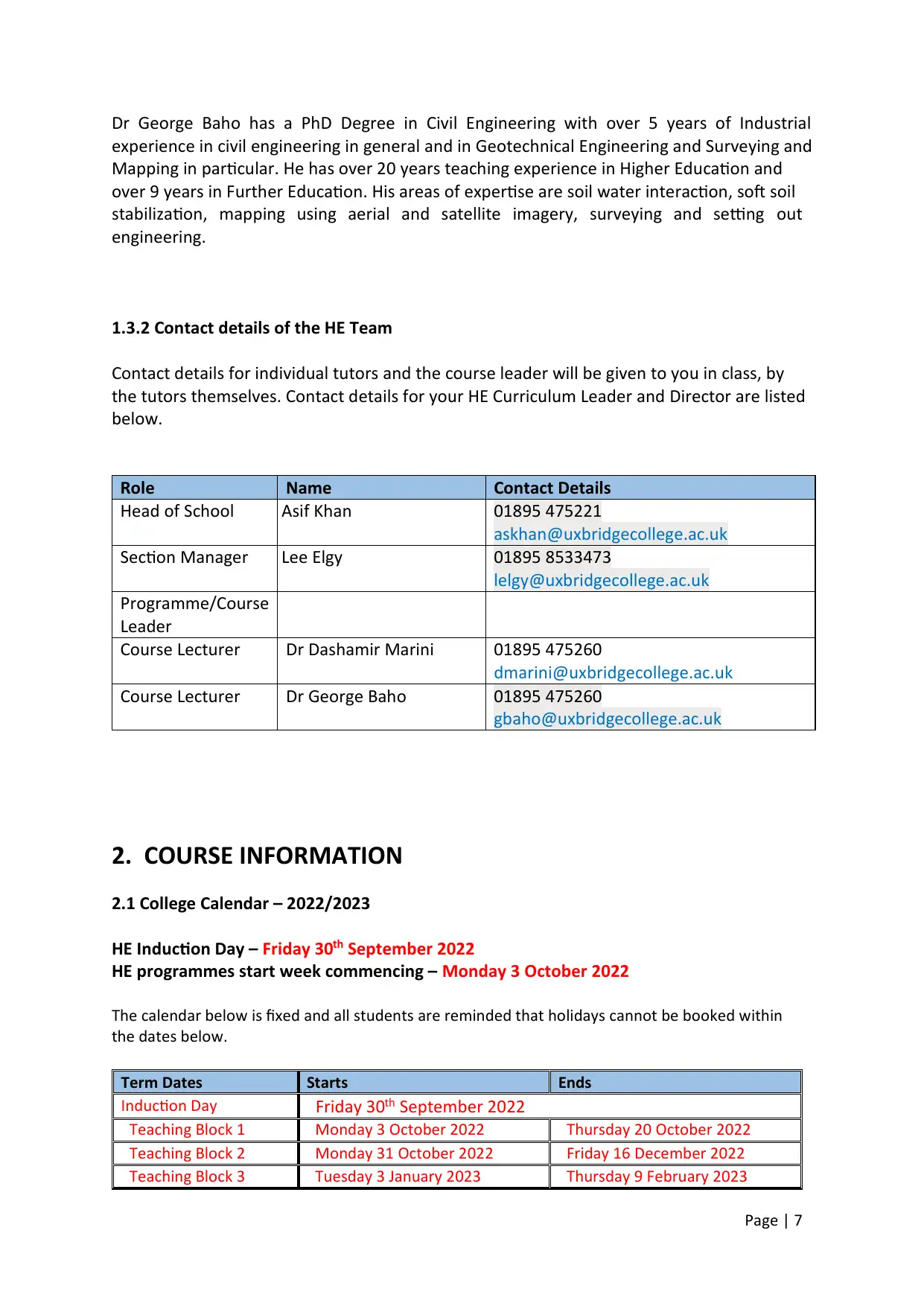
Page | 7
Dr George Baho has a PhD Degree in Civil Engineering with over 5 years of Industrial
experience in civil engineering in general and in Geotechnical Engineering and Surveying and
Mapping in particular. He has over 20 years teaching experience in Higher Education and
over 9 years in Further Education. His areas of expertise are soil water interaction, soft soil
stabilization, mapping using aerial and satellite imagery, surveying and setting out
engineering.
1.3.2 Contact details of the HE Team
Contact details for individual tutors and the course leader will be given to you in class, by
the tutors themselves. Contact details for your HE Curriculum Leader and Director are listed
below.
Role Name Contact Details
Head of School Asif Khan 01895 475221
askhan@uxbridgecollege.ac.uk
Section Manager Lee Elgy 01895 8533473
lelgy@uxbridgecollege.ac.uk
Programme/Course
Leader
Course Lecturer Dr Dashamir Marini 01895 475260
dmarini@uxbridgecollege.ac.uk
Course Lecturer Dr George Baho 01895 475260
gbaho@uxbridgecollege.ac.uk
2. COURSE INFORMATION
2.1 College Calendar – 2022/2023
HE Induction Day – Friday 30th September 2022
HE programmes start week commencing – Monday 3 October 2022
The calendar below is fixed and all students are reminded that holidays cannot be booked within
the dates below.
Term Dates Starts Ends
Induction Day Friday 30th September 2022
Teaching Block 1 Monday 3 October 2022 Thursday 20 October 2022
Teaching Block 2 Monday 31 October 2022 Friday 16 December 2022
Teaching Block 3 Tuesday 3 January 2023 Thursday 9 February 2023
Dr George Baho has a PhD Degree in Civil Engineering with over 5 years of Industrial
experience in civil engineering in general and in Geotechnical Engineering and Surveying and
Mapping in particular. He has over 20 years teaching experience in Higher Education and
over 9 years in Further Education. His areas of expertise are soil water interaction, soft soil
stabilization, mapping using aerial and satellite imagery, surveying and setting out
engineering.
1.3.2 Contact details of the HE Team
Contact details for individual tutors and the course leader will be given to you in class, by
the tutors themselves. Contact details for your HE Curriculum Leader and Director are listed
below.
Role Name Contact Details
Head of School Asif Khan 01895 475221
askhan@uxbridgecollege.ac.uk
Section Manager Lee Elgy 01895 8533473
lelgy@uxbridgecollege.ac.uk
Programme/Course
Leader
Course Lecturer Dr Dashamir Marini 01895 475260
dmarini@uxbridgecollege.ac.uk
Course Lecturer Dr George Baho 01895 475260
gbaho@uxbridgecollege.ac.uk
2. COURSE INFORMATION
2.1 College Calendar – 2022/2023
HE Induction Day – Friday 30th September 2022
HE programmes start week commencing – Monday 3 October 2022
The calendar below is fixed and all students are reminded that holidays cannot be booked within
the dates below.
Term Dates Starts Ends
Induction Day Friday 30th September 2022
Teaching Block 1 Monday 3 October 2022 Thursday 20 October 2022
Teaching Block 2 Monday 31 October 2022 Friday 16 December 2022
Teaching Block 3 Tuesday 3 January 2023 Thursday 9 February 2023
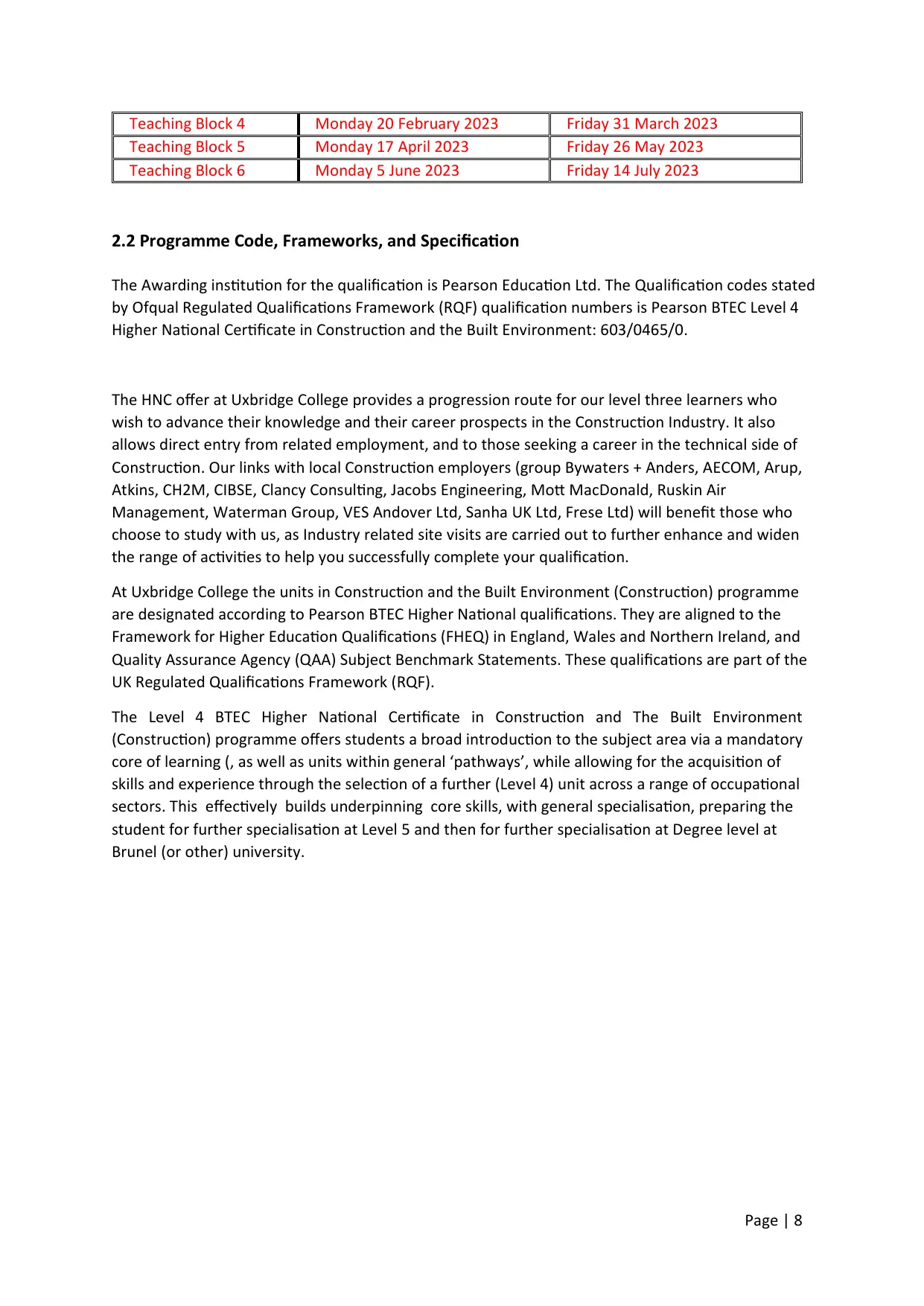
Page | 8
Teaching Block 4 Monday 20 February 2023 Friday 31 March 2023
Teaching Block 5 Monday 17 April 2023 Friday 26 May 2023
Teaching Block 6 Monday 5 June 2023 Friday 14 July 2023
2.2 Programme Code, Frameworks, and Specification
The Awarding institution for the qualification is Pearson Education Ltd. The Qualification codes stated
by Ofqual Regulated Qualifications Framework (RQF) qualification numbers is Pearson BTEC Level 4
Higher National Certificate in Construction and the Built Environment: 603/0465/0.
The HNC offer at Uxbridge College provides a progression route for our level three learners who
wish to advance their knowledge and their career prospects in the Construction Industry. It also
allows direct entry from related employment, and to those seeking a career in the technical side of
Construction. Our links with local Construction employers (group Bywaters + Anders, AECOM, Arup,
Atkins, CH2M, CIBSE, Clancy Consulting, Jacobs Engineering, Mott MacDonald, Ruskin Air
Management, Waterman Group, VES Andover Ltd, Sanha UK Ltd, Frese Ltd) will benefit those who
choose to study with us, as Industry related site visits are carried out to further enhance and widen
the range of activities to help you successfully complete your qualification.
At Uxbridge College the units in Construction and the Built Environment (Construction) programme
are designated according to Pearson BTEC Higher National qualifications. They are aligned to the
Framework for Higher Education Qualifications (FHEQ) in England, Wales and Northern Ireland, and
Quality Assurance Agency (QAA) Subject Benchmark Statements. These qualifications are part of the
UK Regulated Qualifications Framework (RQF).
The Level 4 BTEC Higher National Certificate in Construction and The Built Environment
(Construction) programme offers students a broad introduction to the subject area via a mandatory
core of learning (, as well as units within general ‘pathways’, while allowing for the acquisition of
skills and experience through the selection of a further (Level 4) unit across a range of occupational
sectors. This effectively builds underpinning core skills, with general specialisation, preparing the
student for further specialisation at Level 5 and then for further specialisation at Degree level at
Brunel (or other) university.
Teaching Block 4 Monday 20 February 2023 Friday 31 March 2023
Teaching Block 5 Monday 17 April 2023 Friday 26 May 2023
Teaching Block 6 Monday 5 June 2023 Friday 14 July 2023
2.2 Programme Code, Frameworks, and Specification
The Awarding institution for the qualification is Pearson Education Ltd. The Qualification codes stated
by Ofqual Regulated Qualifications Framework (RQF) qualification numbers is Pearson BTEC Level 4
Higher National Certificate in Construction and the Built Environment: 603/0465/0.
The HNC offer at Uxbridge College provides a progression route for our level three learners who
wish to advance their knowledge and their career prospects in the Construction Industry. It also
allows direct entry from related employment, and to those seeking a career in the technical side of
Construction. Our links with local Construction employers (group Bywaters + Anders, AECOM, Arup,
Atkins, CH2M, CIBSE, Clancy Consulting, Jacobs Engineering, Mott MacDonald, Ruskin Air
Management, Waterman Group, VES Andover Ltd, Sanha UK Ltd, Frese Ltd) will benefit those who
choose to study with us, as Industry related site visits are carried out to further enhance and widen
the range of activities to help you successfully complete your qualification.
At Uxbridge College the units in Construction and the Built Environment (Construction) programme
are designated according to Pearson BTEC Higher National qualifications. They are aligned to the
Framework for Higher Education Qualifications (FHEQ) in England, Wales and Northern Ireland, and
Quality Assurance Agency (QAA) Subject Benchmark Statements. These qualifications are part of the
UK Regulated Qualifications Framework (RQF).
The Level 4 BTEC Higher National Certificate in Construction and The Built Environment
(Construction) programme offers students a broad introduction to the subject area via a mandatory
core of learning (, as well as units within general ‘pathways’, while allowing for the acquisition of
skills and experience through the selection of a further (Level 4) unit across a range of occupational
sectors. This effectively builds underpinning core skills, with general specialisation, preparing the
student for further specialisation at Level 5 and then for further specialisation at Degree level at
Brunel (or other) university.
⊘ This is a preview!⊘
Do you want full access?
Subscribe today to unlock all pages.

Trusted by 1+ million students worldwide
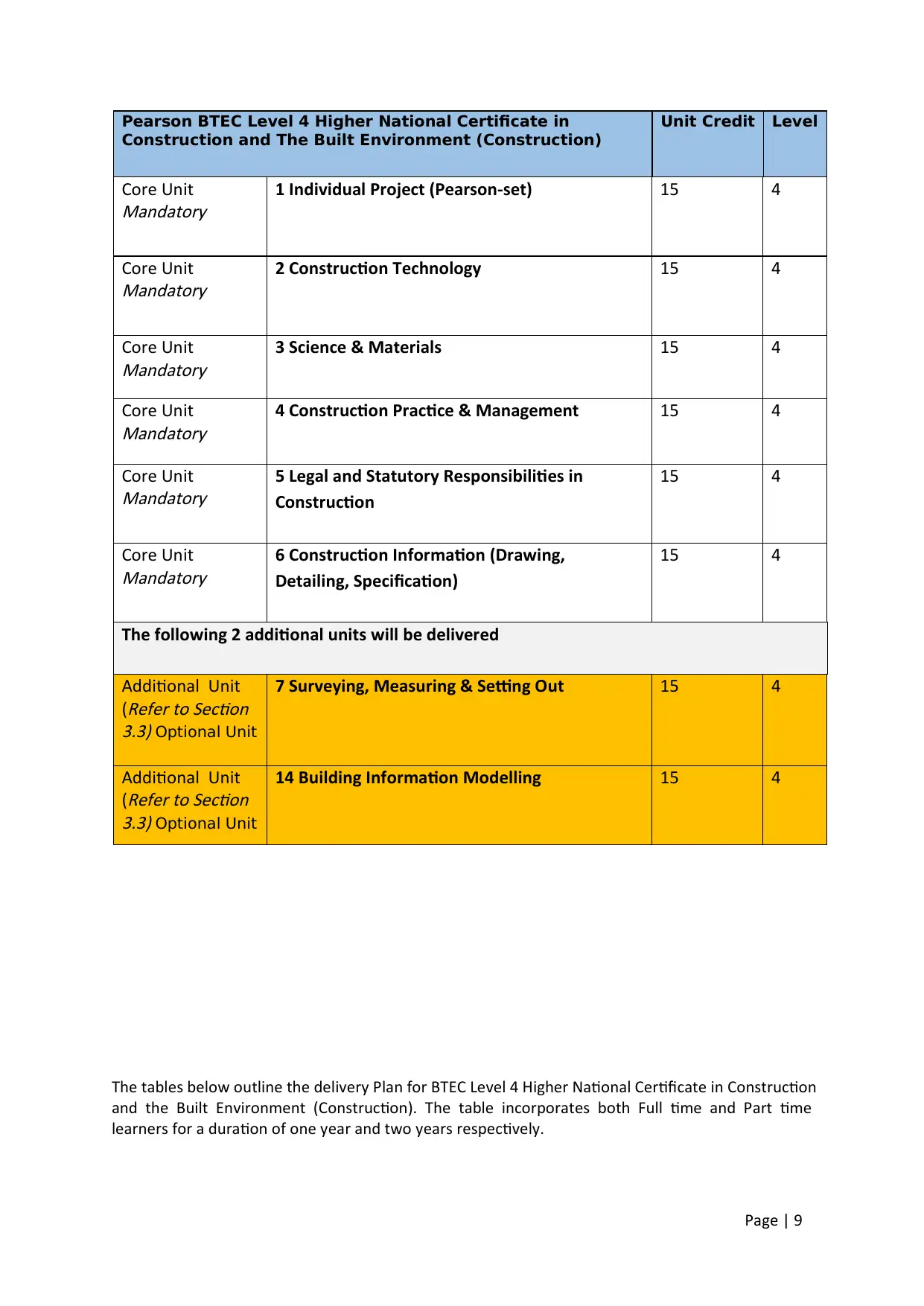
Page | 9
The tables below outline the delivery Plan for BTEC Level 4 Higher National Certificate in Construction
and the Built Environment (Construction). The table incorporates both Full time and Part time
learners for a duration of one year and two years respectively.
Pearson BTEC Level 4 Higher National Certificate in
Construction and The Built Environment (Construction)
Unit Credit Level
Core Unit
Mandatory
1 Individual Project (Pearson-set) 15 4
Core Unit
Mandatory
2 Construction Technology 15 4
Core Unit
Mandatory
3 Science & Materials 15 4
Core Unit
Mandatory
4 Construction Practice & Management 15 4
Core Unit
Mandatory
5 Legal and Statutory Responsibilities in
Construction
15 4
Core Unit
Mandatory
6 Construction Information (Drawing,
Detailing, Specification)
15 4
The following 2 additional units will be delivered
Additional Unit
(
Refer to Section
3.3) Optional Unit
7 Surveying, Measuring & Setting Out 15 4
Additional Unit
(
Refer to Section
3.3) Optional Unit
14 Building Information Modelling 15 4
The tables below outline the delivery Plan for BTEC Level 4 Higher National Certificate in Construction
and the Built Environment (Construction). The table incorporates both Full time and Part time
learners for a duration of one year and two years respectively.
Pearson BTEC Level 4 Higher National Certificate in
Construction and The Built Environment (Construction)
Unit Credit Level
Core Unit
Mandatory
1 Individual Project (Pearson-set) 15 4
Core Unit
Mandatory
2 Construction Technology 15 4
Core Unit
Mandatory
3 Science & Materials 15 4
Core Unit
Mandatory
4 Construction Practice & Management 15 4
Core Unit
Mandatory
5 Legal and Statutory Responsibilities in
Construction
15 4
Core Unit
Mandatory
6 Construction Information (Drawing,
Detailing, Specification)
15 4
The following 2 additional units will be delivered
Additional Unit
(
Refer to Section
3.3) Optional Unit
7 Surveying, Measuring & Setting Out 15 4
Additional Unit
(
Refer to Section
3.3) Optional Unit
14 Building Information Modelling 15 4
Paraphrase This Document
Need a fresh take? Get an instant paraphrase of this document with our AI Paraphraser
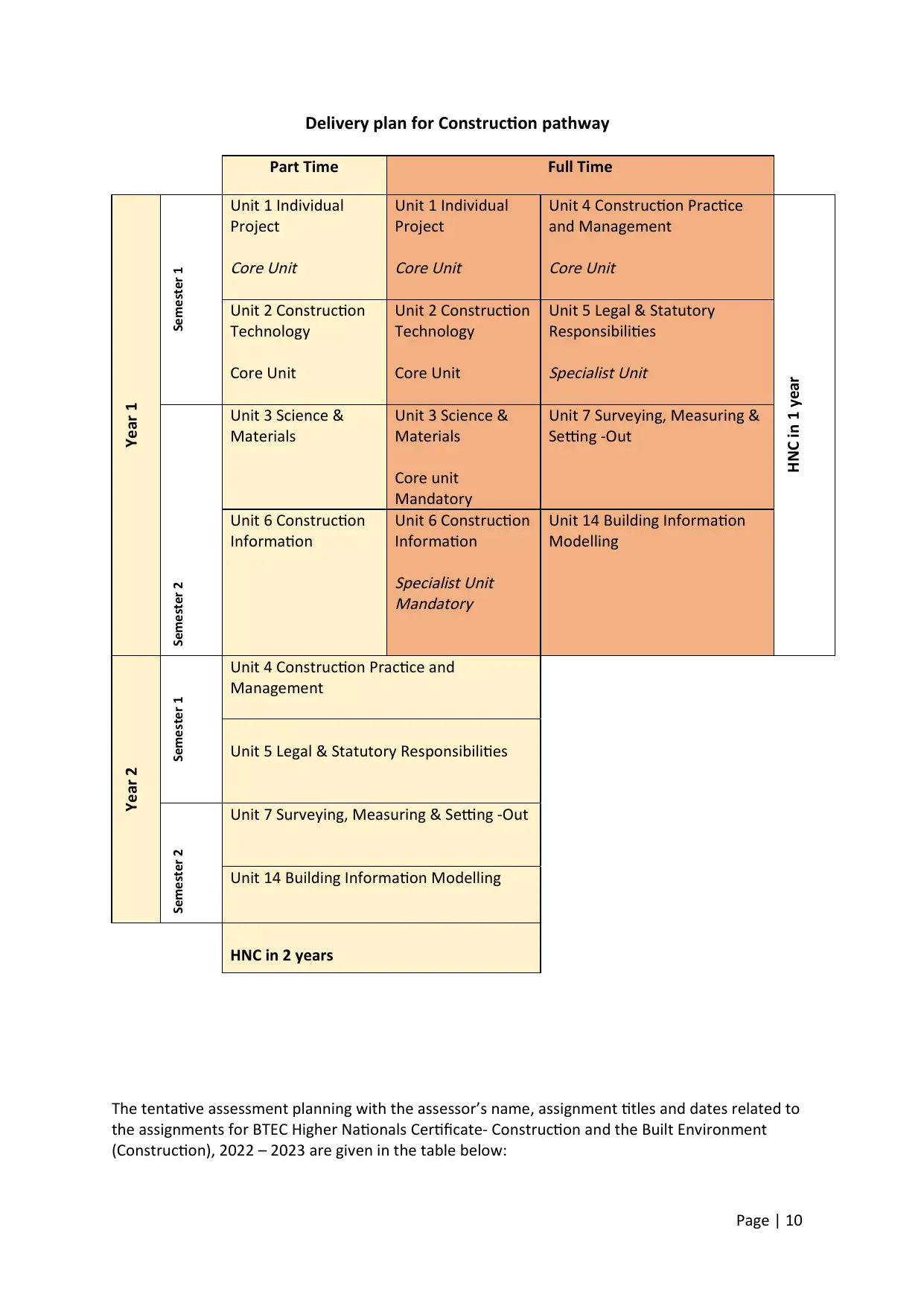
Page | 10
Delivery plan for Construction pathway
Part Time Full Time
Year 1
Semester 1
Unit 1 Individual
Project
Core Unit
Unit 1 Individual
Project
Core Unit
Unit 4 Construction Practice
and Management
Core Unit
HNC in 1 year
Unit 2 Construction
Technology
Core Unit
Unit 2 Construction
Technology
Core Unit
Unit 5 Legal & Statutory
Responsibilities
Specialist Unit
Semester 2
Unit 3 Science &
Materials
Unit 3 Science &
Materials
Core unit
Mandatory
Unit 7 Surveying, Measuring &
Setting -Out
Unit 6 Construction
Information
Unit 6 Construction
Information
Specialist Unit
Mandatory
Unit 14 Building Information
Modelling
Year 2
Semester 1
Unit 4 Construction Practice and
Management
Unit 5 Legal & Statutory Responsibilities
Semester 2
Unit 7 Surveying, Measuring & Setting -Out
Unit 14 Building Information Modelling
HNC in 2 years
The tentative assessment planning with the assessor’s name, assignment titles and dates related to
the assignments for BTEC Higher Nationals Certificate- Construction and the Built Environment
(Construction), 2022 – 2023 are given in the table below:
Delivery plan for Construction pathway
Part Time Full Time
Year 1
Semester 1
Unit 1 Individual
Project
Core Unit
Unit 1 Individual
Project
Core Unit
Unit 4 Construction Practice
and Management
Core Unit
HNC in 1 year
Unit 2 Construction
Technology
Core Unit
Unit 2 Construction
Technology
Core Unit
Unit 5 Legal & Statutory
Responsibilities
Specialist Unit
Semester 2
Unit 3 Science &
Materials
Unit 3 Science &
Materials
Core unit
Mandatory
Unit 7 Surveying, Measuring &
Setting -Out
Unit 6 Construction
Information
Unit 6 Construction
Information
Specialist Unit
Mandatory
Unit 14 Building Information
Modelling
Year 2
Semester 1
Unit 4 Construction Practice and
Management
Unit 5 Legal & Statutory Responsibilities
Semester 2
Unit 7 Surveying, Measuring & Setting -Out
Unit 14 Building Information Modelling
HNC in 2 years
The tentative assessment planning with the assessor’s name, assignment titles and dates related to
the assignments for BTEC Higher Nationals Certificate- Construction and the Built Environment
(Construction), 2022 – 2023 are given in the table below:
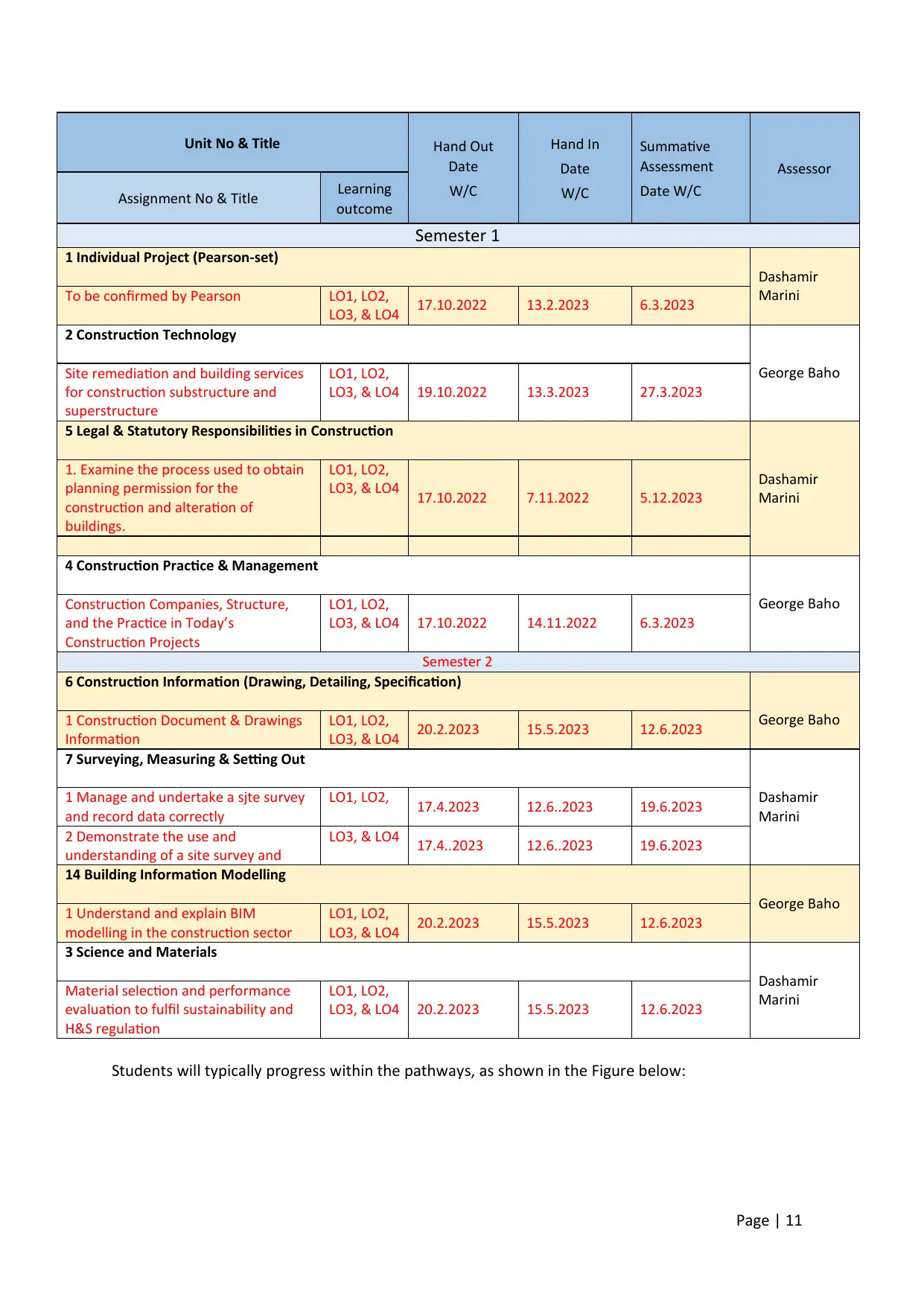
Page | 11
Unit No & Title Hand Out
Date
W/C
Hand In
Date
W/C
Summative
Assessment
Date W/C
Assessor
Assignment No & Title Learning
outcome
Semester 1
1 Individual Project (Pearson-set)
Dashamir
MariniTo be confirmed by Pearson LO1, LO2,
LO3, & LO4 17.10.2022 13.2.2023 6.3.2023
2 Construction Technology
George BahoSite remediation and building services
for construction substructure and
superstructure
LO1, LO2,
LO3, & LO4 19.10.2022 13.3.2023 27.3.2023
5 Legal & Statutory Responsibilities in Construction
Dashamir
Marini
1. Examine the process used to obtain
planning permission for the
construction and alteration of
buildings.
LO1, LO2,
LO3, & LO4 17.10.2022 7.11.2022 5.12.2023
4 Construction Practice & Management
George BahoConstruction Companies, Structure,
and the Practice in Today’s
Construction Projects
LO1, LO2,
LO3, & LO4 17.10.2022 14.11.2022 6.3.2023
Semester 2
6 Construction Information (Drawing, Detailing, Specification)
George Baho1 Construction Document & Drawings
Information
LO1, LO2,
LO3, & LO4 20.2.2023 15.5.2023 12.6.2023
7 Surveying, Measuring & Setting Out
Dashamir
Marini
1 Manage and undertake a sjte survey
and record data correctly
LO1, LO2, 17.4.2023 12.6..2023 19.6.2023
2 Demonstrate the use and
understanding of a site survey and
LO3, & LO4 17.4..2023 12.6..2023 19.6.2023
14 Building Information Modelling
George Baho
1 Understand and explain BIM
modelling in the construction sector
LO1, LO2,
LO3, & LO4 20.2.2023 15.5.2023 12.6.2023
3 Science and Materials
Dashamir
Marini
Material selection and performance
evaluation to fulfil sustainability and
H&S regulation
LO1, LO2,
LO3, & LO4 20.2.2023 15.5.2023 12.6.2023
Students will typically progress within the pathways, as shown in the Figure below:
Unit No & Title Hand Out
Date
W/C
Hand In
Date
W/C
Summative
Assessment
Date W/C
Assessor
Assignment No & Title Learning
outcome
Semester 1
1 Individual Project (Pearson-set)
Dashamir
MariniTo be confirmed by Pearson LO1, LO2,
LO3, & LO4 17.10.2022 13.2.2023 6.3.2023
2 Construction Technology
George BahoSite remediation and building services
for construction substructure and
superstructure
LO1, LO2,
LO3, & LO4 19.10.2022 13.3.2023 27.3.2023
5 Legal & Statutory Responsibilities in Construction
Dashamir
Marini
1. Examine the process used to obtain
planning permission for the
construction and alteration of
buildings.
LO1, LO2,
LO3, & LO4 17.10.2022 7.11.2022 5.12.2023
4 Construction Practice & Management
George BahoConstruction Companies, Structure,
and the Practice in Today’s
Construction Projects
LO1, LO2,
LO3, & LO4 17.10.2022 14.11.2022 6.3.2023
Semester 2
6 Construction Information (Drawing, Detailing, Specification)
George Baho1 Construction Document & Drawings
Information
LO1, LO2,
LO3, & LO4 20.2.2023 15.5.2023 12.6.2023
7 Surveying, Measuring & Setting Out
Dashamir
Marini
1 Manage and undertake a sjte survey
and record data correctly
LO1, LO2, 17.4.2023 12.6..2023 19.6.2023
2 Demonstrate the use and
understanding of a site survey and
LO3, & LO4 17.4..2023 12.6..2023 19.6.2023
14 Building Information Modelling
George Baho
1 Understand and explain BIM
modelling in the construction sector
LO1, LO2,
LO3, & LO4 20.2.2023 15.5.2023 12.6.2023
3 Science and Materials
Dashamir
Marini
Material selection and performance
evaluation to fulfil sustainability and
H&S regulation
LO1, LO2,
LO3, & LO4 20.2.2023 15.5.2023 12.6.2023
Students will typically progress within the pathways, as shown in the Figure below:
⊘ This is a preview!⊘
Do you want full access?
Subscribe today to unlock all pages.

Trusted by 1+ million students worldwide
1 out of 54
Related Documents
Your All-in-One AI-Powered Toolkit for Academic Success.
+13062052269
info@desklib.com
Available 24*7 on WhatsApp / Email
![[object Object]](/_next/static/media/star-bottom.7253800d.svg)
Unlock your academic potential
Copyright © 2020–2025 A2Z Services. All Rights Reserved. Developed and managed by ZUCOL.




